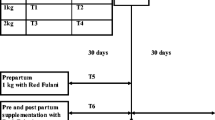Abstract
The effects of calcium (Ca), phosphorus (P) and zinc (Zn) supplementation on reproductive performance of grazing dairy cows was studied. Forty-eight cows in their first to third parity were allocated to eight groups of 6 animals each, based on stage of lactation and milk yield. Groups 1 (control), 2 (Ca), 3 (P) and 4 (Zn) received, respectively, no mineral supplement, 10 g Ca, 8 g P and 400 mg Zn. The rest of the groups received a combination of Ca/P, Ca/Zn, P/Zn or Ca/P/Zn. Animals were drenched daily. Ovarian activity was determined by progesterone concentrations in milk. Prepartum body condition score (BCS) measured using scale 1–5 was 2.5–3.5. Reproductive problems were observed in all groups except that supplemented with Ca. Cows supplemented with Ca, P, Ca/P, Ca/Zn and Ca/P/Zn had significantly (p < 0.05) shorter interval (30 days) from calving to resumption of oestrus as compared to control (69 days). Intervals from calving to conception and between calvings did not differ significantly between groups (p > 0.05), but were shorter in Ca-supplemented cows. Furthermore, cows in groups 2 and 3 needed an average of 2 services per conception against 3 for cows in other groups. Hence, supplementation with Ca, P and Zn of deficient dairy cows appears to improve reproductive performance.
Similar content being viewed by others
Abbreviations
- BCS:
-
body condition score
- Bo:
-
zero progesterone binding
- HP:
-
high progesterone
- LP:
-
low progesterone
- MP:
-
medium progesterone
- Pi:
-
inorganic phosphate
- P4 :
-
progesterone
- RH:
-
relative humidity
- RIA:
-
radioimmunoassay
References
Ali, H.O., Ezzo, O.H. and El-Ekhnawwy, K.E., 1998. Effect of zinc supplementation on reproductive performance of Barki ewes under practical field condition. Veterinary Medicine Journal, Giza, 46, 77–87.
Berthold, E.G.&G., 1995. RIA program. In: Berthold Information. Multi-Crystal Gammar Counter LB2111, 5th edn, (EG&G Berthold). 710–733.
Box, G.E.P., Hunter, W.G. and Hunter, J.S., 1978. Statistics for Experimenters: An introduction to design, data analysis and model building, (Wiley, New York).
Call, J.W., Butcher, J.E., Shupe, J.L., Lake, J.T. and Olson, A.E., 1986. Dietary phosphorus for beef cattle. American Journal of Veterinary Research 47, 475–481.
Dziuk, P.J. and Below, R.A., 1983. Management of reproduction of beef cattle, sheep and pigs. Journal of Animal Science 57(Suppl. 2), 29–39.
FAO/IAEA, 1993. Progesterone RIA, pre- coated tube method. Assay Protocol Version 2.0, (Animal Production and Health Section, Joint FAO/IAEA Division, IAEA, Vienna).
Jonsson, N.N., 1999. The effects of subclinical hypocalcaemia on postpartum fertility. Cattle Practice, 7(3), 255–260.
Jonsson, N.N. and Daniel, R.C.W., 1997. Effects of hypocalcaemia on blood flow to the ovaries of the sheep. Journal of Veterinary Medicine, Series A, 281–287.
Kamgarpour, R., 1996. The effects of subclinical hypocalcaemia on body weight changes, milk production and reproductive performance of dairy cows during the early postpartum period, (PhD thesis, University of Queensland, Australia).
Kaneko, J.J. (ed.), 1989. Clinical Biochemistry of Domestic Animals, 4th edn, (Academic Press, New York), 750–800.
Kasongo, J.C., Mbassa, G.K., Mgheni M. and Kurwijila, R.L., 1997. Analysis of blood chemistry in grazing cows and heifers supplemented with energy and minerals. Tanzania Veterinary Journal, 17(3), 92–103.
Lindsay, D.R., Martin, G.B. and Williams, I.H., 1993. Nutrition and reproduction. In: G.J. King (ed.), Reproduction in Domesticated Animals, (World Animal Science; Elsevier Science, Amsterdam), 459–485.
McDowell, L.R., 1987. Assessment of mineral status of grazing ruminants. World Review of Animal Production 33(4), 19–31.
NRC (National Research Council), 1989. Nutrient Requirements of Dairy Cattle, 6th edn, (National Academy of Science, Washington, DC).
Pereka, A.E. and Phiri, E.C.J.H., 1998. Mineral content in soils and pasture grasses at ASAS farm, Iringa, Tanzania. Tanzania Veterinary Journal, 18(2), 101–109.
Phiri, E.C.J.H., Pereka, A.E., Mgasa, M.N. and Larsen T., 1997: Plasma calcium and inorganic phosphorus in grazing cattle at ASAS farm, Iringa, Tanzania. Tanzania Veterinary Journal 17(3), 44–49.
Read, M.V.P., Engels, E.A.N. and Smith, W.A., 1986. Phosphorus and the grazing ruminants. 1. The effect of supplementary P on sheep at Armoedsvlakte. South African Journal of Animal Science, 16, 1–6.
Richard, M.W., Spitzer, J.C. and Warner, M.B., 1986. Effect of varying levels of postpartum nutrition and body condition at calving on subsequent reproductive performance in beef cattle. Journal of Animal Science, 62, 300–306.
SAS (Statistical Analysis System), 1990. SAS Applications Programming: A Gentle Introduction, (Duxbury Press, Belmont CA), 449–482.
Sendalo, D.S.C., 1988. Soil forages and animal tissues mineral status and the effect of mineral supplementation on performance of lambs, (MSc thesis, Sokoine University of Agriculture, Morogoro, Tanzania).
Scharp, D.W., 1980 Infertility in dairy cows associated with hypocalcaemia. Australian Veterinary Journal, 56, 302.
Smith, O.B. and Akinbamijo, O.O., 2000. Micronutrients and reproduction in farm animals. Animal Reproduction Science, 60–61, 549–560.
Underwood, E.J., 1981. The Mineral Nutrition of Livestock, 2nd edn, (CABI Wallingford: Commonwealth Agriculture Bureaux).
Underwood E.J. and Suttle, N.F., 1999. Mineral Nutrition of Livestock, 3rd edn, (CAB International, New York).
Wahab, S., Jainndeen, M.R. and Azizuddin, K., 1990. Monitoring reproductive performance of crossbred dairy cattle on smallholder farms in Malaysia. In: Studies on the Reproductive Efficiency of Cattle Using Radioimmunoassay Techniques, Proceedings of the Final Research Coordination Meeting, Vienna Austria, 5–9 September 1988, 35–43.
Ward, G., Marion, G.B., Campbell, C.W. and Dunham, J.R., 1971. Influences of calcium intake and vitamin D supplementation on reproductive performance of dairy cows. Journal of Dairy Science, 54, 204–206.
Whitman, R.W., 1975. Weight change, body condition and beef cow reproduction, (PhD dissertation, Colorado State University, Fort Collins).
Wilderman, E.E., Jones, G.M., Wagner, P.E., Boman, R.L., Trott Jr, H.F. and Lesch, T.N., 1982. A dairy cow body condition scoring system and its relationship to selected production characteristics. Journal of Dairy Science, 65, 495–500.
Author information
Authors and Affiliations
Corresponding author
Rights and permissions
About this article
Cite this article
Phiri, E.C.J.H., Nkya, R., Pereka, A.E. et al. The effects of calcium, phosphorus and zinc supplementation on reproductive performance of crossbred dairy cows in Tanzania. Trop Anim Health Prod 39, 317–323 (2007). https://doi.org/10.1007/s11250-007-9016-2
Accepted:
Published:
Issue Date:
DOI: https://doi.org/10.1007/s11250-007-9016-2




